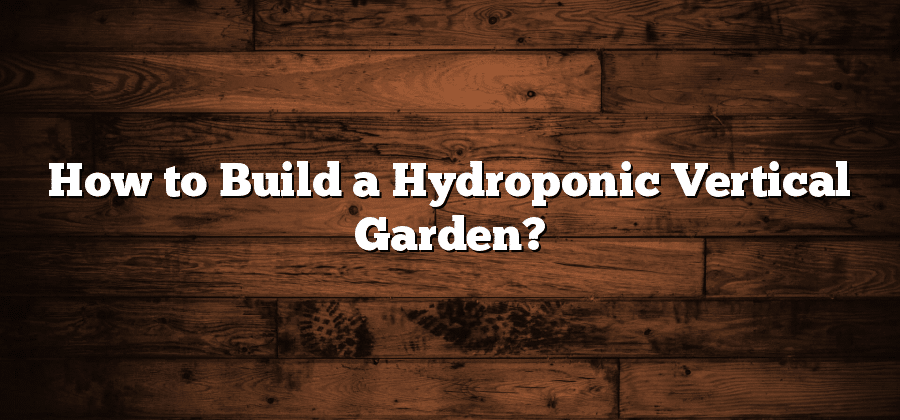Benefits of a Hydroponic Vertical Garden
While traditional gardening techniques have their own charm, hydroponic vertical gardens offer a range of unique benefits. One significant advantage is their space-saving nature. With a hydroponic vertical garden, you can grow a variety of plants in a small area, making them perfect for urban dwellers or those with limited yard space. Additionally, vertical gardens eliminate the need for soil, reducing the risk of pests and weeds, and making maintenance much easier.
Another advantage of hydroponic vertical gardens is their ability to conserve water. Unlike traditional gardening, which requires ample amounts of water to nurture plants in the soil, hydroponic systems use up to 90% less water. This is because the water in hydroponics is recycled, flowing through the roots of the plants and back into the system. Not only does this save water, but it also reduces the environmental impact associated with excessive water usage. Additionally, by eliminating the need for soil, hydroponic gardens also prevent water wastage through evaporation and runoff.
Selecting the Right Location for Your Garden
One of the most critical factors to consider when setting up a hydroponic vertical garden is selecting the right location. The success of your garden depends on finding an area that provides adequate sunlight and easy access to water and electricity. Ideally, you should choose a spot that receives at least six hours of direct sunlight each day, as this is essential for the plants to grow and flourish. It is important to avoid areas that are shaded or blocked by nearby structures, as this can hinder the growth of your plants. Additionally, selecting a location that allows for easy access to a water source and power supply will make it more convenient for you to maintain and monitor your garden’s performance.
Another aspect to consider when selecting the right location for your hydroponic vertical garden is the available space. Before installing your garden, measure the dimensions of the area you have in mind and ensure that it can accommodate the size and design of your vertical garden system. Take into account both the height and width requirements to ensure that your plants have enough space to grow vertically and spread out horizontally. Moreover, consider the stability of the location, as it should be able to support the weight of the vertical garden and provide a secure foundation. By carefully selecting the right location for your hydroponic vertical garden, you can set the stage for a thriving and productive green oasis.
Choosing the Best Plants for Hydroponic Vertical Gardening
Hydroponic vertical gardening offers a wide range of possibilities when it comes to selecting the best plants for your setup. Because you are not limited by soil conditions, you have the freedom to grow a variety of plants that may not thrive in traditional gardening methods. When choosing plants for your hydroponic vertical garden, it is important to consider factors such as space availability, lighting needs, and water requirements.
Leafy greens, such as lettuce, spinach, and kale, are popular choices for hydroponic vertical gardens. These plants have shallow root systems and can be easily accommodated in the vertical setup. Additionally, they grow quickly and are high in nutritional value, making them an ideal choice for home gardeners looking to cultivate fresh produce. Herbs, such as basil, mint, and parsley, are also well-suited for hydroponic vertical gardening. They thrive in controlled environments and benefit from the constant supply of water and nutrients. With the proper care, these herbs can provide a year-round supply of aromatic leaves for use in cooking and other applications.
Understanding the Basics of Hydroponics
Hydroponics is a unique method of gardening that eliminates the need for soil by using a nutrient-rich water solution to grow plants. This innovative technique provides a controlled environment for plant growth, allowing for optimal development and maximum yield. In a hydroponic system, plants receive essential nutrients directly through their root systems, ensuring that they have everything they need to thrive.
One of the key advantages of hydroponics is its ability to conserve water. Unlike traditional gardening methods, hydroponics requires less water because it recirculates and reuses the nutrient solution. Additionally, hydroponic systems can be set up in smaller spaces, making it an ideal option for urban dwellers or those with limited garden area. With proper monitoring and management, hydroponics offers consistent and faster plant growth, resulting in higher crop productivity. By understanding the basics of hydroponics, you can embark on a more sustainable and efficient way of gardening with impressive results.
Determining the Size and Design of Your Vertical Garden
Determining the size and design of your vertical garden is a crucial step in creating a successful and visually appealing setup. The first thing to consider is the available space you have. Measure the area where you intend to install the vertical garden to ensure that it can accommodate the desired size. Keep in mind that vertical gardens are typically more space-efficient than traditional gardens, as they take advantage of vertical spaces. However, it is important to allow enough room for the plants to grow and thrive.
In addition to size, the design of your vertical garden plays a significant role in its overall aesthetic and functionality. There are various design options to choose from, depending on your preferences and the style of your space. You can opt for a stacked arrangement, where plants are placed on top of each other in a tiered fashion. Another option is a pocket design, where individual pockets or planters are attached to the wall. Alternatively, you could consider a modular setup, where separate units can be combined to create a larger vertical garden. Whatever design you choose, make sure it allows for easy maintenance and access to the plants for watering and harvesting.






